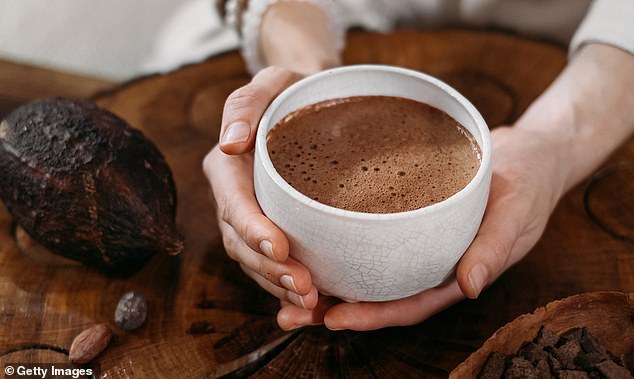A health coach has revealed an unexpected weight loss aid – and it is good news for chocoholics.
Steve Bennett, the author of Fibre First, told the Sun how drinking a cup of hot chocolate could help dieters shift some pounds.
However, not just any old mug of the sweet stuff will do, those hoping to slim down should use a homemade recipe, according to the author and health coach.
He says that making the drink with unsweetened cocoa powder can help you feel less hungry by boosting your fibre intake.
It is believed that many people do not consume the recommended amount of fibre daily.
Hot chocolate made with unsweetened cocoa powder and stevia could help with weight loss, according to health coach Steve Bennett (stock image)
However, it is important to do so as not only does it help keep you regular, fibre is also difficult to digest.
As a result, it keeps you fuller for longer, and can help stop you craving snacks – which can often be behind weight gain.
Steve told the Sun: ‘Having more fibre in your diet makes you eat less and keeps you feeling fuller for longer.
‘Cocoa powder, which should be the main ingredient in hot chocolate, is high in fibre. The problem with the shop-bought versions in the UK is they have too much sugar and e-numbers. But you can have a simple healthy version that tastes just as good.’
He added that most diets are based on having to give things up, which people do not like doing.
However, he explained: ‘If you put the fibre first you can eat whatever you like afterwards but you will end up eating, less because you feel fuller.’
Steve’s recipe for hot chocolate features 200ml of warm milk, with two heaped tablespoons of plain cocoa powder and two teaspoons of stevia sweetener.
Fibre is not only helpful for weight loss, it has other health benefits too, with a 2015 study suggesting that people who eat a high fiber diet are less likely to die of any cause.

According to health coach Steve, adding fibre to your diet can help you stay fuller for longer, and help reduce your cravings for snacks (stock image)
The authors behind the study, which included 1,000,000 people, said fibre has the potential to lower the risk of chronic diseases including heart disease, stroke, diabetes and several types of cancer.
Individuals should be encouraged to increase their dietary fibre intake ‘to potentially decrease the risk of premature death,’ they said.
Yang Yang, of the Shanghai Cancer Institute in China, and colleagues write in the American Journal of Epidemiology.
They pooled data from 17 previous studies that tracked 982,411 men and women, mostly in Europe and the U.S., and recorded about 67,000 deaths.
Yang’s team divided participants into five groups based on their daily fibre intake.
Those in the top fifth, who ate the greatest amount of fibre daily, were 16 percent less likely to die than those in the bottom fifth, who consumed the least amount of fibre.
In addition, eight studies showed a 10 percent drop in risk for any cause of death with each 10-gram per day increase in fibre intake.
According to NHS guidelines, adults should consume around 30g of fibre daily, but most only eat around 20g.
‘On average, intakes of dietary fibre in the U.S. and other economically developed countries are much lower than recommended goals – in the U.S., about half of what is advised,’ said Victoria Burley, a nutrition researcher at the University of Leeds in the UK, who was not involved in the study.
These study results are ‘very much in line with earlier published meta-analyses of the relationship between dietary fibre and risk of major chronic diseases such as cardiovascular disease, and cancers,’ Burley told Reuters Health in an email.
She said the benefits of consuming fibre-rich foods have been known for decades, including lowering of blood cholesterol, blood pressure, blood glucose and insulin, and possibly reducing inflammation.
High-fibre foods may also make people feel full sooner, and for longer, which helps curb overeating and weight gain, she added.
‘Some or all of these factors may underlie the reduction in mortality observed here.’
It’s not difficult to consume an extra 10 grams of fibre per day, Burley said.
‘This can come from two servings of whole grain foods, such as breakfast cereal and two servings of fruit or vegetables, for example.’
She cautioned, however, that the current study does not prove that eating more fibre is the reason some participants lived longer.
Their reduced risk of death might be due to some other shared characteristic, like an overall healthier lifestyle, or perhaps some other property of the high-fibre foods, which tend to be nutritious in general.






Site fantástico Muitas informações úteis aqui, estou enviando para alguns amigos e também compartilhando deliciosas E, claro, obrigado pelo seu suor